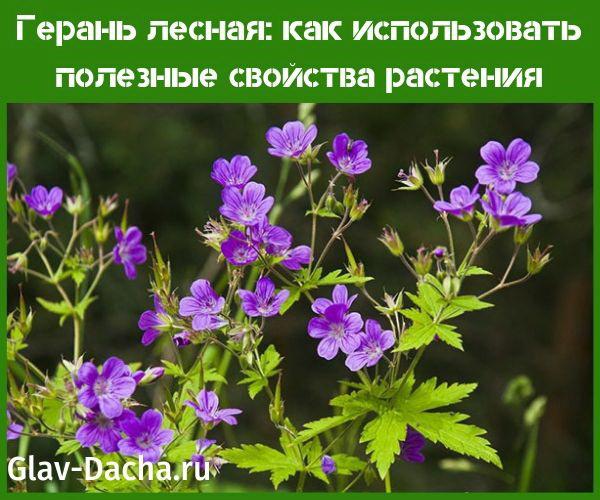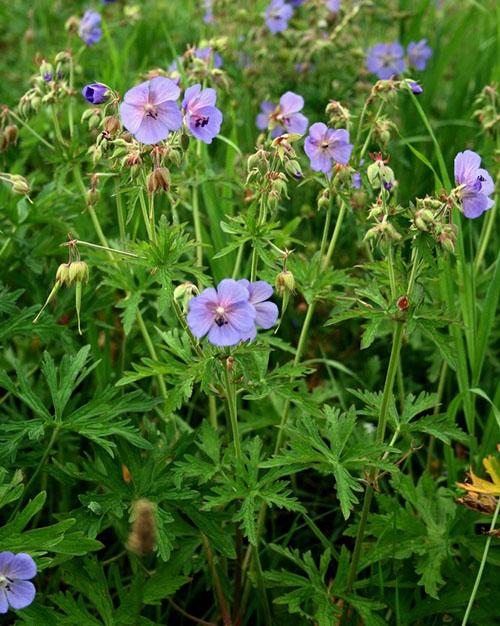Forest geranium: how to use the beneficial properties of the plant
 Forest geranium is a herb belonging to the geranium family. Perennial. It grows mainly in cold and temperate climatic zones of Eurasia. On the territory of Russia, it is most often found in the North Caucasus, in the European part of the country, as well as in Siberia. It is called differently in every region.
Forest geranium is a herb belonging to the geranium family. Perennial. It grows mainly in cold and temperate climatic zones of Eurasia. On the territory of Russia, it is most often found in the North Caucasus, in the European part of the country, as well as in Siberia. It is called differently in every region.
Egorovo spear, Zhuravelnik, Usova grass, Grabelki, Pins - the people gave all these names to the Geranium sylvaticum plant.
Forest geranium, photo and description of the plant

What a forest geranium looks like can be seen in the photo. Geranium flowers are relatively large, purple or violet, two on one peduncle. The inflorescence is a multi-flowered dichasium. The plant blooms in June. The first fruits begin to ripen in early August. Their shape resembles a bird's beak.
Forest geranium can be found in coniferous and mixed forests, next to shrubs. The plant prefers fertile, humus-rich soil.
Forest geranium and the content of nutrients in it
 The chemical composition of a plant can vary depending on the type and place of growth, not only in quantitative but also in qualitative proportion.
The chemical composition of a plant can vary depending on the type and place of growth, not only in quantitative but also in qualitative proportion.
In the root system of forest geraniums are synthesized:
- various tannins, the content of which can be up to 22%;
- alkaloids;
- starch;
- acids and their salts.
The ground part of the plant contains vitamin C, as well as sucrose, fructose, glucose, flavonoids and gallotannins and ellagitannins. Forest geranium seeds contain leukocyanides, due to which antioxidant properties are manifested. The vegetative mass of wild-growing species of geranium accumulates various trace elements - copper, manganese, nickel, zinc.
Geraniol - one of the components of geranium essential oil is widely used in the perfumery industry.
The healing properties of forest geranium
 Wild geranium is harvested during the flowering period. The collected plants are dried in the shade, outdoors or under a roof, in the attic. If the grass is not suspended in bunches, it must be mixed. The shelf life of dry raw materials is 2 years. The roots of some species can also be used as medicinal raw materials. They are dug in late autumn, after the top of the plant has died out.
Wild geranium is harvested during the flowering period. The collected plants are dried in the shade, outdoors or under a roof, in the attic. If the grass is not suspended in bunches, it must be mixed. The shelf life of dry raw materials is 2 years. The roots of some species can also be used as medicinal raw materials. They are dug in late autumn, after the top of the plant has died out.
Homemade leaves pelargonium use fresh. Since this plant does not have an obvious dormant period, raw materials can be collected at any time of the year.
Most types of geraniums have remarkable medicinal properties. The plant contains essential oil, which is why it has such a memorable smell, but not as sharp as its indoor counterpart. The most "outstanding" aroma is in Robert's geranium, which is popularly called "stinky".
The ground part of forest geranium is mainly used as a remedy, rhizomes are used less often.Traditional healers have recommended many ways to obtain healing tinctures and decoctions, all kinds of rubbing and oils.  The infusions have disinfectant and antibacterial properties. With their help, throat diseases are treated - sore throat, tonsillitis, pharyngitis. The astringent properties of geranium are used to treat diseases of the gastrointestinal tract. Most often, medicinal raw materials in folk medicine are necessary for the preparation of external agents. They are very effective in stopping blood in case of various damage to the skin, cuts, abrasions, wounds. They also reduce pain from bruises and soothe itching.
The infusions have disinfectant and antibacterial properties. With their help, throat diseases are treated - sore throat, tonsillitis, pharyngitis. The astringent properties of geranium are used to treat diseases of the gastrointestinal tract. Most often, medicinal raw materials in folk medicine are necessary for the preparation of external agents. They are very effective in stopping blood in case of various damage to the skin, cuts, abrasions, wounds. They also reduce pain from bruises and soothe itching.
Application
 A decoction of forest geranium is effective in the deposition of salts, osteochondrosis, articular rheumatism. It will also help with diarrhea. You can prepare it in the following way: pour 1.5 teaspoons of crushed roots with a glass of cold water (250 g) and boil over low heat for 20 minutes. Take several sips during the day.
A decoction of forest geranium is effective in the deposition of salts, osteochondrosis, articular rheumatism. It will also help with diarrhea. You can prepare it in the following way: pour 1.5 teaspoons of crushed roots with a glass of cold water (250 g) and boil over low heat for 20 minutes. Take several sips during the day.
Geranium herb is used as an external agent and for rinsing the throat and mouth for sore throat, skin diseases, severe hair loss, for quick healing of wounds and ulcers. 0.5 liters of water will require 2 teaspoons of raw materials. Boil for 15 minutes, and then infuse for 1 hour.
Sometimes, instead of a decoction, an aqueous infusion is prepared. This is the so-called "cold method". Two teaspoons of chopped herbs are infused in 0.5 liters of cooled boiled water for 8 hours. Apply in the same way as a regular decoction.
Treatment of forest geraniums is contraindicated in young children, pregnant and lactating women, people suffering from chronic gastrointestinal diseases, varicose veins and thrombophlebitis, as well as allergy sufferers.